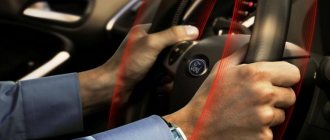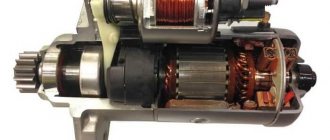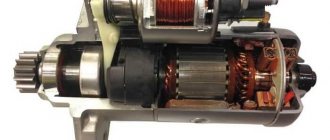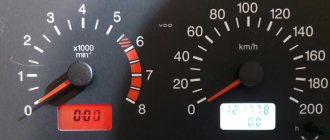If the steering wheel of a VAZ 2114 shakes when braking, this eloquently indicates the presence of vibration in the car. The reasons why this vibration occurs are very different. We will talk about some of them below. Steering wheel wobble indicates a problem in one or more mechanisms. And if the cause of this vibration is not found in a timely manner and it is not eliminated, then not only will the vibrating unit or part of the car wear out and fail. Vibration will also negatively affect other systems where it is felt.
Why does the steering wheel shake? 7 Main Causes of Steering Wheel Vibration
Care and attention to the technical condition of the car is our direct responsibility. And it doesn’t matter how we feel about it, whether it’s a “workhorse” for us, a means of transportation or a luxury item. First of all, its serviceability is our safety.
And one of the reasons to pay serious attention to your car is the vibration of the steering wheel when driving, or, as experienced drivers say, the beating of the steering wheel. It is expressed in completely different ways and at different speeds, for some at 30 km/h, and for others at 70 km/h. It doesn't really matter. What matters is the fact that there is something wrong with the mechanical part of the car. Let's look together at the seven main causes of this vibration and how to eliminate them. And I’ll tell you about another interesting reason, which is rare, at the end.
Wrong wheel alignment
Wheel alignment is another important parameter that is set by adjusting the wheel position. Camber is the angle of the wheel relative to the vertical. The fact is that the wheels are installed on the car not strictly parallel to the vertical, but at a slight angle, which is not always noticeable to the average person. Toe-in, or toe-in, is the angle between the plane of rotation and the direction of movement of the car. Wheel alignment affects vehicle stability on the road, cornering, and the rate of tire wear. If this parameter is adjusted incorrectly, the steering wheel may wobble.
Snow and dirt in the wheel
The first and most common reason is snow freezing or dirt sticking to the inside of the wheel rim. This usually happens in winter. Due to lumps of snow and dirt stuck to the rim, wheel imbalance occurs, which causes quite strong vibration not only in the steering wheel, but throughout the entire body. The help of specialists is not required here; it is enough to find an overpass and remove everything that is unnecessary from the disks using a metal brush. You can also remove each wheel separately and perform the same operation, as you wish. The only point that cannot be missed is that when removing with a brush or something else, do not dismantle the balancing weights, which are very often glued to the inside of alloy wheels, so that you do not have to go to a tire shop and re-balance.
How is a malfunction diagnosed?
To identify the runout of one of the front wheels, you will need a jack, wheel chocks and a wheel wrench. The diagnostic procedure is as follows:
- Park the machine on level ground and pull the handbrake all the way. Additionally, secure the car with boots placed under any rear wheel.
- Jack up the front wheel until it hangs off the ground. On vehicles with front-wheel drive and all-wheel drive, be sure to move the gearshift lever to neutral.
- Rotate the suspended rim with your hands. If you feel stuck in a certain position, remove the wheel and check that the uneven disc is rubbing against the pads, causing strong vibration when braking.
The essence of the diagnosis is simple: after operation, the brake pads move back just enough to free the rotating surfaces. The lining must be forced apart to its maximum open position. If the metal working part is bent, then when rotating the part will begin to get stuck between the pads.
Advice. It is not a fact that jerking of the steering wheel in different directions is caused by deformation of one disc. It is likely that the second element is also bent. Therefore, be sure to check both front mechanisms for defects. At the same time, inspect the parts for cracks (especially after a side impact).
If the vibration does not cause the car to deviate from a straight path while driving and does not cause the steering wheel to twitch, check the suspension and chassis components. Drive the vehicle into the inspection ditch and jerk the steering rods to check for play. The performance of shock absorbers is checked by rocking the car up and down with body weight. After applying force, the machine should swing no more than 1 time.
Wheel mount
Fastening a wheel or tightening it with bolts and nuts is perhaps the most dangerous reason why vibration can occur at low speed. Through her fault, we can crash if the fasteners fall off while driving and the wheel flies off the car. Therefore, if you feel vibration, do not be lazy and check whether all the wheels are tight. You can also contact the service, where specialists will do this using a special tool. After all, in addition to the risk of getting into an accident, poor wheel fastening can lead to rapid wear of suspension parts. And this, in turn, is not a timely expense.
Causes of pedal beat.
There are actually not many components in a car's braking system that can fail and lead to this problem. If the brake pedal starts to beat, then first of all you should check the main components of the system:
It is important to remember that replacing brake discs, pads or drums is done in pairs, on each axis. After replacement, you need to run in the parts a little. This can be done by braking several times while driving in first gear. The run-in should be done in a place where there are no people or other cars nearby, so that if any problems arise, it will not cause an accident.
Tire pressure
Another factor that can cause the steering wheel to wobble is tire pressure. Vibration will appear at speed, although for this reason it occurs more often throughout the body. The steering wheel is almost not noticeable. If there is a difference in pressure in the wheels, the car will also pull to the side. In other words, you will keep the steering wheel straight, and the car will drive either to the left or to the right. This can be solved by simply equalizing the pressure at any gas station, tire shop, or wherever there is a tire inflation hose.
Wheel imbalance
Wheels, like tires, although they have an ideal appearance, and even on rolling machines their shape is absolutely ideal, unfortunately, they have different densities of the material from which they are made. For example, the density of the alloy in the disk may differ in different places, which in turn will add or decrease weight in this place. The same is true with tires. Thus, when assembling the wheel, we get an imbalance caused by different weights in different places of the wheel as it rotates. Which in turn will lead to vibration in the steering wheel at speeds of approximately 80 km/h. This can be corrected by balancing the wheels at a tire shop.
What to do if the brake system is working properly.
If a visual inspection does not reveal any faults, or after replacing any elements the problem still persists, you need to check the following elements:
- wheel balancing.
- suspension arms, their fastenings
- brake system fastening elements
Problems with the brake system should not be ignored. In the future, this can lead to more expensive repairs or accidents on the roads.
Brakes, without exaggeration, are the most important system of any vehicle, since not only a calm and comfortable ride, but also the life of the driver and his passengers depends on its smooth and uninterrupted operation. The validity of this statement is confirmed by many years of statistics and personal experience of a multi-million army of car enthusiasts.
There are quite frequent cases when symptoms appeared in an apparently serviceable braking system that forced the car owner to be at a loss about the true technical condition of the brake system elements. Let's look at the most common of them.
Crooked wheels
Although roads in big cities are getting better, this is not happening everywhere. And here and there we come across potholes, potholes and holes into which we drive with our wheels, thereby damaging either tires or wheels. And it happens that both of them happen, so much so that it is no longer possible to restore them. So, after such damage, strange vibrations appear, which can also manifest themselves both in the body and in the steering wheel. To determine this, it is necessary to remove the wheels and conduct a visual inspection of the rim for dents and deformations. But more accurately, this can be seen on a balancing machine in a tire shop, when the wheel rotates. There you can clearly see whether the disc is hitting or whether the tire itself is bent. Since the tire has a metal cord inside, with a strong impact it breaks and a lump or hernia appears on the wheel, as a result of which the rubber is deformed and becomes egg-shaped. This can be corrected in this way: replace the tire and roll the disc on a rolling machine.
Indirect reasons, what is included here
If the brake pedal hits when you press the brake, don’t limit yourself to studying the direct causes. There are situations when failures in other mechanisms lead to malfunctions.
Here we can highlight:
1. Worn wheel bearings. Read how to replace a wheel bearing.
2. Damage (deformation) of the levers on the front wheel (“saber”).
3. Problems with wheel balancing. It is easy to recognize - vibrations will be felt not only in the brake pedal, but throughout the entire car body. Ignoring the problem is life-threatening.
Immediately go to a service station and have the wheels balanced. If this does not help, then the only solution may be to buy a new product.
4. Pulling bolts (nuts). At the first sign of runout, check the quality of the screws. This reason is trivial, but it is precisely because of poor-quality broaching that play and beating in the brake pedal can appear. You can spend a considerable amount of money on repairs, and then come across loose bolts (nuts).
Chassis
Operating a car is, of course, an individual thing. The more carefully we drive, the longer our car will serve us. But sooner or later, running parts and assemblies begin to wear out. And this, in turn, is also one of the reasons for steering wheel vibrations. Tie rod ends and rods, wheel bearings and steering rack. As soon as wear and play appear in the suspension, it begins to transmit to the steering wheel all the unevenness and defects of the road surface on which we are driving, thus creating steering runout. And also causing vibrations in the body. The solution to this problem is diagnostics and repair of the chassis and steering.
Vibrations when braking
Since front disc brakes appeared, the list of causes of steering wheel vibrations has been supplemented with one more. Often the cause of this malfunction is aggressive driving (fast acceleration and sharp deceleration). By squeezing the brake pedal at high speed, we heat up the brake disc to such an extent that it takes the shape of a figure eight. Brake pads begin to follow the shape of the disc when braking. Vibration occurs in the wheel, which is transmitted to the steering wheel through the steering. This is how we get the steering wheel beating when braking. This vibration is also accompanied by beating of the brake pedal. In very rare cases, a brake disc may burst due to severe overheating, which will lead to the wheel jamming, the car will lose control and an accident may occur. This type of vibration can also be caused by a worn wheel bearing. Due to the play that occurs when it wears out, a similar vibration of the steering wheel occurs. The solution to both situations is to visit a car service center and have it repaired.
And, as promised, there is one more reason that very few people know about!
Brake pedal squeaks after installing new parts
If the brake system has recently been repaired, the most possible reasons are:
- poor quality installation
- low quality spare parts
- combination of the above two factors
In this case, the right decision would be to visit another service station.
It is strictly forbidden to drive a car at high speed if the brake pedal hits when braking. And if the vibration is very strong, then it is advisable to call a tow truck and not risk your life.
The braking system is one of the main components of a car, which allows you to respond in a timely manner to obstacles while moving in traffic without causing emergency situations. A slow response to pressing the pedal can cause a collision with the car in front, and too sharp a response will interfere with cars behind. And in general, any malfunction in the brake system invariably leads to a decrease in pedal response time, the driver cannot predict the movement of the car and the chance of getting into an accident increases sharply. One of the manifestations of a malfunction in the brake system may be that the Chevrolet Niva brake pedal hits when braking. If this problem occurs, you should immediately diagnose the brake system and fix the problem.
Factory defect of stamped discs!
Defects of stamped (iron) disks are not so common, but they do occur. I encountered this from personal experience. After many attempts, one person will get rid of steering wheel vibration. In which he did absolutely everything from the above. He was asked to replace his new, imported, iron, IDEAL wheels with cast ones. And, lo and behold, the steering wheel vibration disappeared! What was it? He asked after that. Here's what! At the disk manufacturing plant, apparently something happened to the equipment and during the production of the disks, the mounting holes shifted 3-5mm to the side! Thus, the wheel on the balancing machine looked ideal and was also perfectly balanced, but when placed on the car, it was shifted to the side by bolted connections and began to jump when moving, causing the steering wheel to wobble, and given that all 4 disks on his car had such a defect, then and the vibration was noticeable not only in the steering wheel, but also in the body.
How to detect wear on brake discs?
Before repairing, it is necessary to diagnose the breakdown.
Is it just the steering wheel that vibrates? The likely cause is wear of the front brake discs or the system as a whole. Has the brake pedal also changed its behavior? Pay attention to the rear braking system. The handbrake can be used to determine the malfunction. If the vibration stops when using it, then you should look for a problem in the front brake system. Is there any beat left? Examine the technical condition of the rear brake discs and the system as a whole. The procedure allows you to determine the location of deformed parts.
Next, you should test the wheels or study the appearance of the brake discs. Raise the car on a jack and remove it from gear. If the rear axle is suspected, then the handbrake must be lowered. Spin the wheel. Is the rotation uneven and changing intensity in the same place? The problem has been identified. If the test result is negative, move on to the next wheel.
The appearance of the brake disc says a lot about its technical condition. Noticed cracks, unevenness or chips? Replacement or grooving is required, depending on the situation. The presence of a bluish tint on the surface is a sign of overheating.
When inspecting, pay attention to the brake calipers. It's unlikely, but they can also cause vibrations in the steering wheel.
Vibrations on the steering wheel: what are the reasons and how to deal with them
Even if car enthusiasts react quite nervously to such common phenomena as the rattling of glass and plastic inside a car, vibration of the steering wheel can put almost every driver in a mental hospital - this is a very annoying and unpleasant process. Jokes aside, vibrations on the steering wheel are a very serious problem. Today we will find out the reasons for its occurrence and tell you how to cope with this disaster.
Steering wheel vibration
Causes of vibrations on the steering wheel
As a rule, vibrations in the steering wheel appear under various conditions: when the car is moving at different speeds, braking, or when the car is stationary and its engine is idling. If the beating of the steering wheel has become annoying, you need to determine in what circumstances it manifests itself, and depending on this, diagnose the cause.
Steering wheel wobble when the car is stationary
Vibrations in this case can occur for two reasons: due to loose engine mounts or due to problems with the steering rack drive shaft. In the first option, when the engine is idling, the steering wheel hits quite hard. Such vibrations appear on cars with high mileage: either the mountings of the power unit have become loose over time, or the engine was not installed properly after a major overhaul. If even at low speeds a significant beating of the steering wheel is felt, then as the speed increases, the vibrations increase and driving such a car becomes not only uncomfortable, but also unsafe.
The second option: the occurrence of vibrations at idle speed in a stationary car can be caused by wear of the splined part of the steering rack drive shaft or deformation of the shaft itself. With this option, the steering wheel runout may also increase when the car moves.
The photo shows a ball joint. Read about it here
You cannot drive with such vibrations for a long time because it can lead to destruction of the steering mechanism elements, and, as a result, loss of control of the car - an accident.
Steering wheel vibration when driving at different speeds
Here there are more factors causing vibrations, and they are mainly related to the condition of the wheels.
Firstly, steering wheel beating can occur due to the fact that the wheel rims become clogged with snow or dirt, which leads to imbalance of the wheels and, as a result, the appearance of those same annoying vibrations. In this case, the steering wheel only shakes at low speeds, and when the speed increases, the vibrations disappear completely.
Secondly, steering wheel vibrations can occur at medium (no more than 60 km/h) and high speeds if the wheels were not properly balanced during a seasonal tire change or after tire repair.
wheel balancing
In this case, the masses of the wheels become different; when the speed increases, the centrifugal forces of such wheels differ, which is why the steering wheel wobbles. You can’t drive with unbalanced wheels for a long time - in addition to driving discomfort, you can ruin the tires (uneven wear) or, more seriously, damage the suspension elements (in this case, the hub bearings suffer the most).
Thirdly, steering wheel beating can be caused by deformation of the wheel rims (most often steel wheels are susceptible to this). Most often, vibrations in this case occur after the car has crashed into a pothole with one or even two wheels. It happens that a deformed wheel rim is sold to you in a store or market - this is a manufacturing defect. It is not always possible to determine by eye whether crooked rims are the cause of vibrations on the steering wheel - often this bends the inner part of the rim, not the outer one.
The disk is bent on the inside
You can diagnose this reason by removing the wheels yourself, or by contacting the nearest tire shop.
Fourthly, steering wheel vibration may occur if the holes in the wheel rim do not match the diameter of the bolts on the wheel hub. This manifests itself when non-original rims are installed on the car. In this case, the disc begins to “jump” on the hub, vibration occurs, which is transmitted to the steering wheel. The higher the speed, the more the steering wheel vibrates.
Fifthly, steering “fever” occurs due to tire defects. This includes deformation of the cord or sidewall of the tire, which can be caused by manufacturing defects or improper use of the rubber (driving on roads with potholes).
This can cause a herniation on the wheel
The sixth reason for vibration at speed is uneven tire pressure. Due to the fact that there are different pressures in the wheels on the same axle, the steering wheel begins to shake even at low speeds.
Another cause of vibration in the steering wheel, which can occur at medium and high speeds, is unevenly tightened or loose wheel bolts. In the first case, due to the fact that the bolts are tightened with different forces, a misalignment occurs when the wheel rotates. The greater its centrifugal force, the stronger the distortion and the more noticeable the beating of the steering wheel. In the second case, if the bolts are loosened, the wheel begins to “jump” on the hub, generating vibrations that radiate into the steering wheel.
Finally, worn-out suspension or steering components can lead to vibrations in the steering wheel. Wear of these parts leads to the appearance of backlashes of various sizes, and the larger they are, the more severely the steering wheel hits at speed. In this case, the appearance of vibrations on the steering wheel serves as a signal to check the suspension or steering elements. For example, vibration in the steering wheel may occur when cornering. Worn constant velocity joints (CV joints) or failed silent blocks of the front arms are to blame for this. And if the steering wheel shakes when driving over bumps, we risk breaking the steering rack bushings.
CV joint malfunction
Steering wheel wobble when braking
Vibrations in the steering wheel when braking occur due to deformation of the elements of the car's braking system - brake discs or drums. A change in the shape of discs or drums can be caused by a) a manufacturing defect; b) improper operation of the brake system (overheating of the brake discs followed by sudden cooling).
Lack of balancing
Wheel balancing is performed when it is necessary to align the mass of the wheel to the center. The fact is that the rubber density in different parts of the wheel is not the same, and this leads to a shift in the center of gravity of the wheels. This causes vibration, rapid and uneven wear of rubber, and driving a vibrating car is not very comfortable. Wheel imbalance is one of the reasons for the VAZ 2114 steering wheel to wobble. There is only one solution to the problem - go to a tire shop for balancing.











